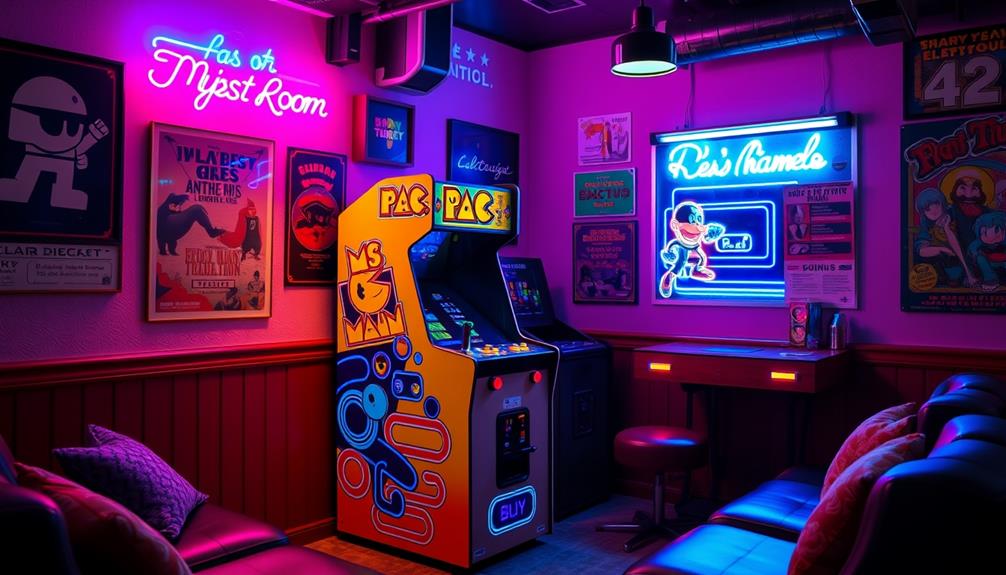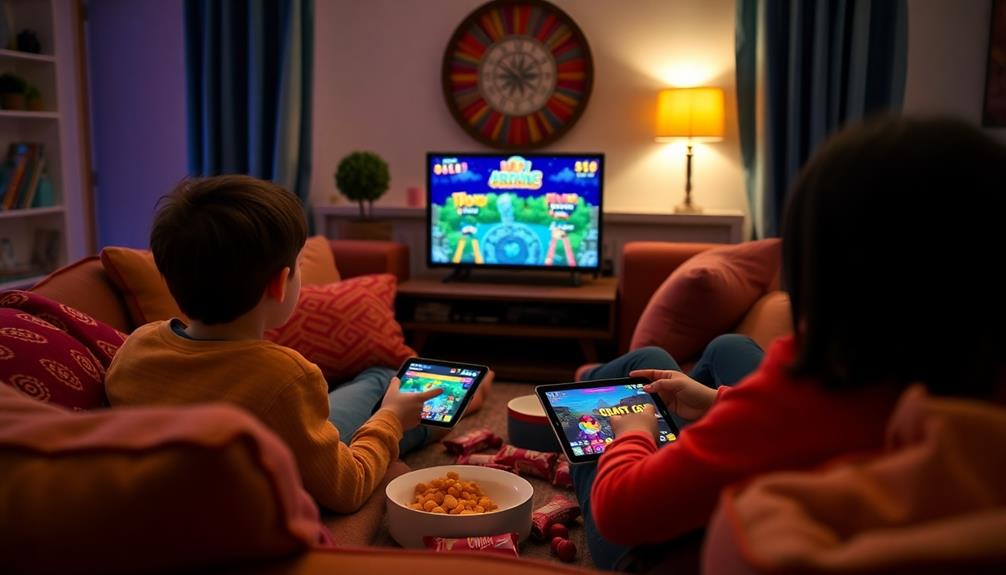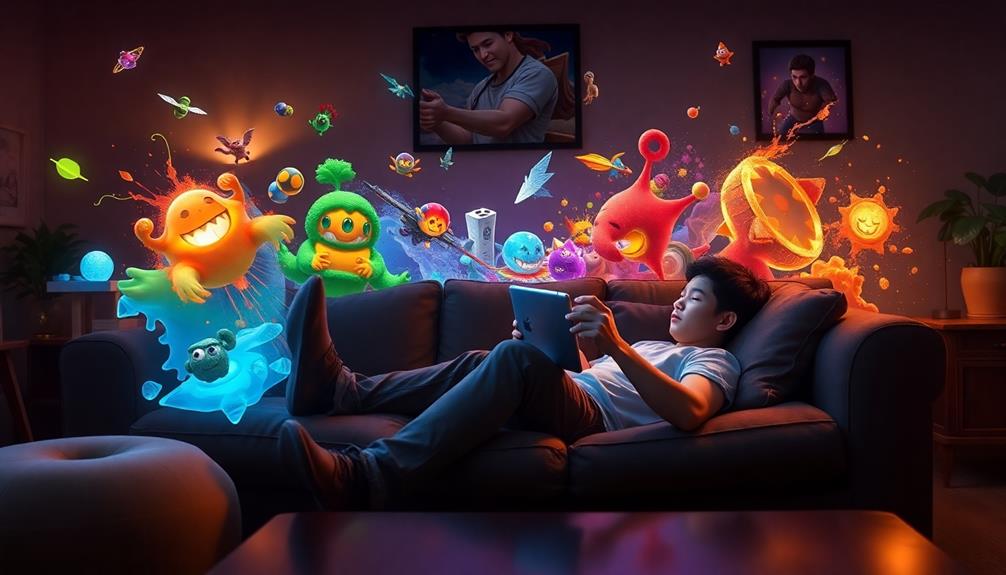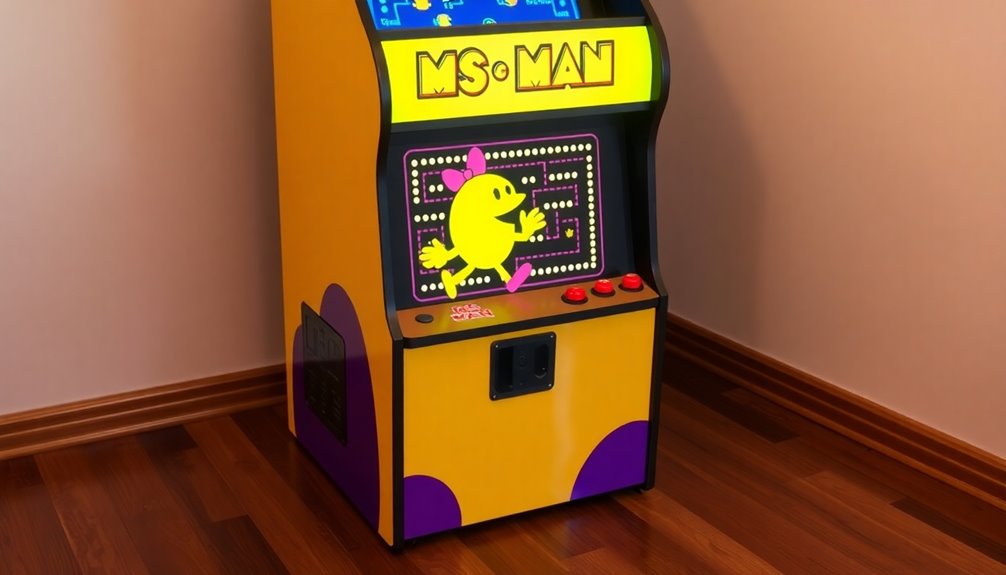The Ms. Pac-Man Cabinet is the perfect addition to your retro arcade collection! With its vibrant neon graphics and authentic design, it’s bound to make a statement. Enjoy 14 iconic games, such as Ms. Pac-Man and Galaga, with a user-friendly control layout that ensures smooth gameplay for all. Additionally, with Wi-Fi connectivity, you can compete in online leaderboards. Priced at $500, this cabinet is a great value for any arcade enthusiast. With convenient shipping options and a customer-friendly return policy, adding this gem to your collection is a breeze. Stay tuned for more details on this essential arcade experience!
Key Takeaways
- The Ms. Pac-Man Cabinet features 14 classic games, including Ms. Pac-Man and Galaga, providing a diverse gaming experience for retro enthusiasts.
- Its sleek design with vibrant neon graphics and a light-up marquee enhances the visual appeal of any arcade setup.
- The responsive joystick and intuitive control layout ensure comfort and precision for both newcomers and veteran players.
- Wi-Fi capability allows players to track high scores and compete on online leaderboards, fostering friendly competition.
- With a retail price of $500 and a 90-day return policy, it offers great value and customer satisfaction.
Cabinet Design

The allure of the Ms. PAC-MAN arcade cabinet lies in its enchanting cabinet design, which perfectly marries nostalgia with vibrant aesthetics.
You'll notice its sleek black background, adorned with eye-catching neon graphics that transport you right back to the golden age of classic games. The striking imagery of Ms. Pac-Man being chased by colorful ghosts creates an inviting atmosphere, making it hard to resist jumping in for a game.
A thoughtful design element is the pink trim riser, which adds a playful pop of color that draws attention. This accent complements the retro vibe and enhances the overall visual appeal.
The faux coin door not only adds authenticity but also evokes memories of traditional gaming halls, making your arcade experience feel genuine.
Completing the design is the light-up marquee that prominently displays Ms. Pac-Man's logo, ensuring that this cabinet stands out in any setup.
With its combination of nostalgic charm and modern flair, the Ms. PAC-MAN arcade cabinet isn't just a game; it's a stunning centerpiece that transforms your space into a retro arcade wonderland. The bright, colorful artwork and classic joystick controls make the Ms. PAC-MAN arcade cabinet a must-have for any gaming enthusiast. The iconic sound effects and thrilling gameplay of the pac man arcade game will transport you back to the golden age of arcade gaming, providing endless entertainment for you and your guests. Whether you’re reliving your own arcade memories or introducing a new generation to the excitement of the pac man arcade game, this arcade cabinet is sure to be a hit in any home or game room.
Game Selection
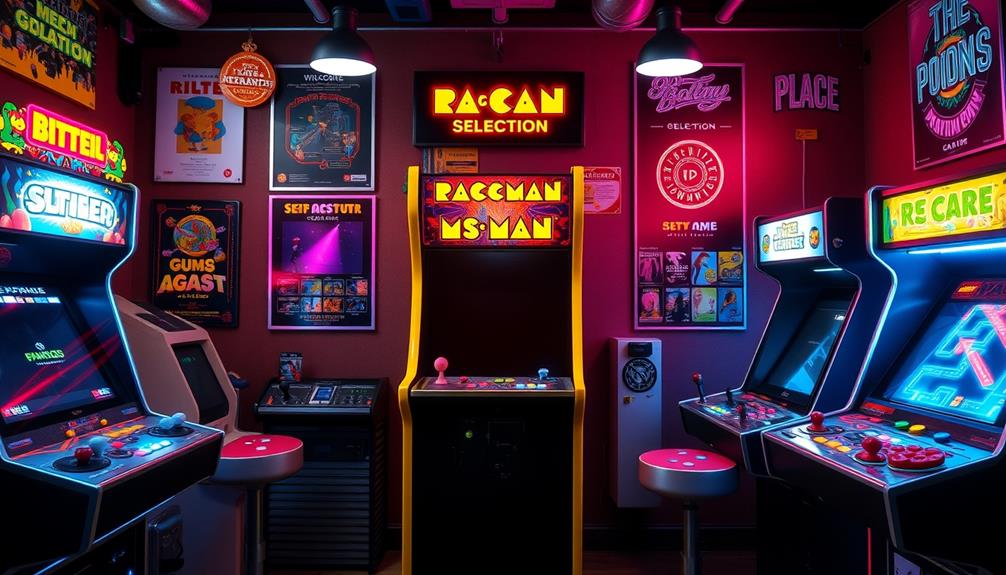
With a lineup of 14 classic games, the Ms. PAC-MAN arcade cabinet is a treasure trove for retro gaming enthusiasts. This game selection not only showcases the beloved Ms. PAC-MAN but also includes iconic titles that guarantee hours of fun.
You'll love the variety and unique mechanics each game offers, keeping your gaming experience fresh and exciting.
- Ms. PAC-MAN: Faster gameplay for a thrilling chase!
- Galaga: Engage in epic space battles with challenging enemies.
- Dig Dug: Dig deep and pop your enemies for high scores!
The cabinet's Wi-Fi capability takes your gaming to the next level, allowing you to track your high scores and compete against players worldwide on online leaderboards.
You can challenge your friends or simply aim to beat your own records, adding a competitive edge to your arcade gameplay.
This diverse selection encourages social interaction, whether you're inviting friends over or joining online competitions.
With so many classic games at your fingertips, you'll find something that appeals to everyone, making it the perfect addition to your retro arcade setup!
Control Deck Features
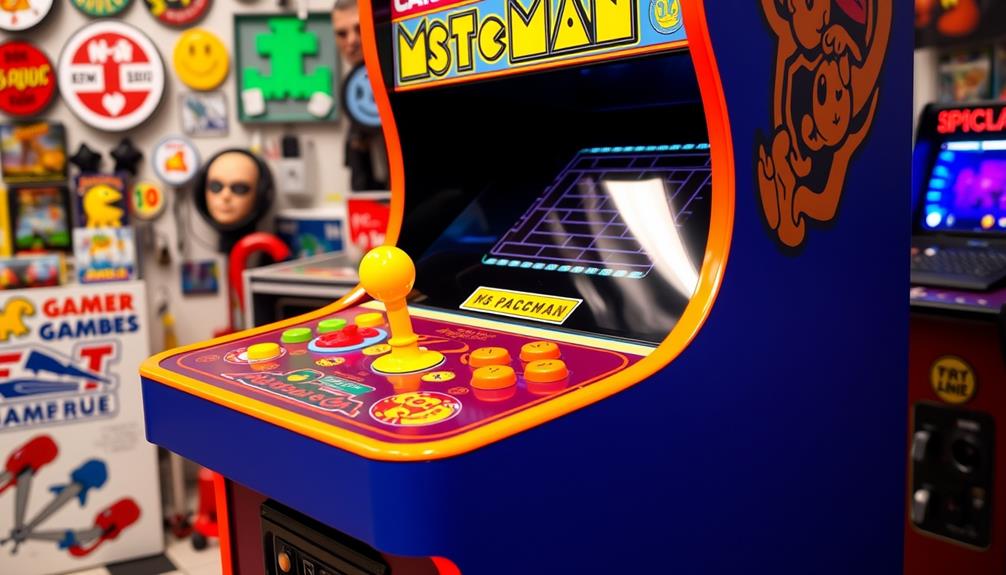
The control deck of the Ms. Pac-Man cabinet sports an intuitive layout that makes it easy for you to jump right into the action.
With a responsive joystick design, you'll feel every move you make as you navigate through the maze.
This setup not only enhances your gameplay but also captures the essence of the classic arcade experience.
Intuitive Control Layout
An intuitive control layout makes gameplay seamless and enjoyable, ensuring you feel right at home with the Ms. Pac-Man cabinet. The control deck is designed with your comfort in mind, allowing for quick and easy access to all the essential controls.
You'll appreciate the familiar setup that mirrors the original arcade experience, making it perfect for both newcomers and seasoned players.
Here are some key features of the intuitive control layout:
- Central Joystick: The responsive joystick is centrally located for precise movement and control, enhancing your gameplay experience.
- Easily Accessible Buttons: Start buttons and a live button are strategically placed, allowing you to jump into action without missing a beat.
- Vintage Aesthetic: The acrylic surface, inspired by classic arcade cabinets, not only looks great but also adds to the nostalgic feel of your gaming setup.
With its intuitive control layout, the Ms. Pac-Man cabinet invites you to enjoy hours of fun while reliving those iconic gaming moments.
You'll find that every game feels natural, enhancing your overall enjoyment.
Responsive Joystick Design
Experience unmatched precision with the responsive joystick design featured in the Ms. Pac-Man cabinet. This central joystick is engineered for quick, accurate movements, enhancing your gameplay in the iconic PAC-MAN Classic Arcade Game. You'll appreciate how this responsive joystick design lets you navigate mazes and dodge ghosts with ease, making every session more enjoyable.
The control deck also includes conveniently positioned start buttons and a live button, ensuring you can jump into action without any delay. Crafted with an acrylic surface, the joystick and buttons replicate the tactile feel of vintage arcade cabinets, immersing you in nostalgia as you play. You'll feel connected to the roots of gaming.
The side art proudly displays the Ms. Pac-Man logo, adding a touch of flair while helping you easily identify the controls. Every detail in the layout of the control deck is meticulously designed to recreate the authentic arcade experience, catering to both new players and retro gaming enthusiasts.
With this responsive joystick design, you'll find yourself lost in the classic gameplay, reliving the excitement of the arcade era right in your own home. Get ready to enjoy every moment!
Game Mechanics

How do game mechanics elevate the excitement of classic arcade titles like Ms. Pac-Man? The game's faster-paced action amps up the challenge, making every moment thrilling. You'll find yourself dodging ghosts and collecting pellets with a sense of urgency that keeps you on your toes.
Consider these engaging game mechanics that enhance your gaming experience:
- Speed: Ms. Pac-Man's quicker gameplay compared to the original Pac-Man heightens the intensity.
- Strategy: Releasing power-ups in Super Pac-Man adds layers of strategy, allowing you to plan your moves carefully.
- Unique Movement: Jumping mechanics in Pack Land introduce a fresh way to navigate obstacles, breaking the mold of traditional gameplay.
These elements create a fun game that's not just about nostalgia but also about skill and strategy. Each arcade title builds upon the last, offering unique twists that keep players hooked.
Whether you're maneuvering through mazes or blasting enemies in Galaga, these game mechanics guarantee that every session is packed with excitement.
Pricing and Availability

Finding the perfect retro arcade cabinet can be thrilling, and the Arcade1Up Ms. PAC-MAN is a great choice at an accessible retail price of $500. This pricing makes it an attractive option for retro gaming enthusiasts looking to enhance their collection without breaking the bank.
You can easily purchase the Ms. PAC-MAN cabinet directly from Arcade1Up, ensuring you receive a genuine product that meets high-quality standards. The availability through their official site also means you can trust you're getting the real deal.
Plus, you'll be delighted to know that the cabinet comes packed with 14 classic games, offering a variety of gameplay experiences that cater to every nostalgic gamer.
Don't forget to keep an eye out for regular promotions and discounts; these can provide you with potential savings that make this retro gem even more appealing.
With its nostalgic value and the excitement of classic games, the Ms. PAC-MAN cabinet offers a fantastic opportunity to relive the arcade magic right in your home.
Shipping and Return Policies

When you order your Ms. PAC-MAN cabinet, you can enjoy 30 days of free shipping and choose your shipping plan at checkout.
If you're local, check for nearby pickup options to save on shipping fees and get your cabinet faster.
Plus, if you're not satisfied, the easy 90-day return policy makes it simple to send it back.
Free Shipping Options
Free shipping is an excellent perk for anyone looking to purchase a Ms. PAC-MAN cabinet. With 30 days of free shipping, you can enjoy a cost-effective delivery option that makes adding this retro gem to your arcade setup even more enticing.
Just make sure to select an eligible shipping plan at checkout to take advantage of this fantastic offer!
Here are a few key points to keep in mind:
- Place your order within 2 hours and 37 minutes to guarantee arrival by September 20.
- The return policy offers 90 days for free returns, ensuring you have plenty of time to decide if the cabinet meets your expectations.
- Refunds for returned items are processed within a specified timeframe, enhancing your overall satisfaction.
With these options, you can confidently order your Ms. PAC-MAN cabinet knowing that free shipping and a straightforward return policy are designed to make your experience seamless.
Easy Return Process
Returning your Ms. PAC-MAN cabinet is a breeze, thanks to the generous 90-day return policy. If you find that the cabinet doesn't meet your expectations, you can easily initiate a return within this timeframe. This hassle-free process is designed to guarantee your satisfaction and boost your confidence in your purchase.
To qualify for a full refund, make sure the item is returned in its original condition. This standard return practice helps streamline the process and assures that you won't face any unexpected issues.
Keep in mind that while returns are generally straightforward, return shipping fees may apply for certain items, so it's wise to check the specific return conditions before sending anything back.
Once your return is processed, you can expect a swift refund for eligible products, which adds another layer of ease to your shopping experience.
By offering a clear and accommodating return policy, the company enhances overall customer satisfaction, giving you peace of mind as you enjoy your retro arcade setup.
Don't hesitate to reach out if you have any questions about the return process or need assistance.
Pickup Availability Details
If you're looking to bring home your Ms. PAC-MAN cabinet, you'll be pleased to know about the convenient pickup availability tailored for local customers. You can easily check nearby pickup locations, allowing you to collect your cabinet quickly and skip the wait.
Here are some benefits of choosing in-store pickup:
- No Shipping Fees: Save money by avoiding shipping costs with in-store collection.
- Quick Collection: Get your cabinet faster without waiting for delivery.
- 30 Days of Free Shipping: If you opt for delivery, enjoy free shipping for a limited time.
For those who prefer delivery, rest assured that your Ms. PAC-MAN cabinet is eligible for 30 days of free shipping if you order within the specified timeframe.
Plus, if you find the cabinet doesn't meet your expectations, the hassle-free return process allows you to return items within 90 days at no charge. Refunds are processed quickly, ensuring your satisfaction with the overall purchasing experience.
Frequently Asked Questions
Is the Cabinet Suitable for Small Living Spaces?
Yes, the cabinet's compact design makes it ideal for small living spaces. You'll appreciate how it fits snugly into corners or tight areas, letting you enjoy classic gaming without sacrificing valuable floor space.
Can I Customize the Graphics on the Cabinet?
You've got a canvas, not just a cabinet. While the classic design's nostalgic charm pulls at your heartstrings, customizing the graphics lets your creativity shine, transforming it into a unique statement piece for your space.
Does It Support Multiplayer Gaming Options?
Yes, it supports multiplayer gaming options! You can challenge friends or family to compete against each other, enhancing the fun. Just grab some extra controllers, and you're all set for an exciting gaming session!
What Age Group Is This Cabinet Appropriate For?
This cabinet's perfect for all ages, but kids around 8 and up will really enjoy it. It's designed for family fun, so you'll find everyone from teenagers to adults having a blast together!
Are There Any Maintenance Requirements for the Cabinet?
You'll want to keep an eye on the cabinet's components. Regularly clean the screen and controls, check for loose connections, and guarantee the power supply's working. A little maintenance goes a long way in preserving gameplay.
Conclusion
In the world of retro gaming, adding an Ms. Pac-Man cabinet might just be the ultimate game-changer for your arcade setup. Some say it's not just about nostalgia; it's also about the social experience of gathering friends for a friendly competition. With its sleek design and engaging gameplay, you'll find yourself drawn back to those thrilling arcade days. So, why not embrace the magic of Ms. Pac-Man and create new memories while reliving the old?
